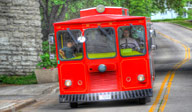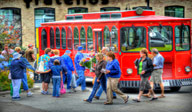March 11th Meeting
Public Input Workshop
Twenty neighbors, community leaders and Riverfront advocates joined together to participate in a public input workshop March 11 at Pullman’s Restaurant.
Participants were asked four questions to help define what a great neighborhood means to them. They were:
- What makes Appleton a great place to live?
- What makes a great neighborhood?
- What makes a great building?
- What makes a great riverfront?
Community feedback will be incorporated into the project design process and business recruitment efforts. A summary of the feedback is listed below. If you would like to share your suggestions/feedback with the project developers, please use the contact us page on this website. Thank you!
- 1. Question: What Makes Appleton a great place to live?
Group A:
- Lawrence University offers a lot of arts
- Easy to drive, park, get around – low hassle
- Safe, walkable, manageable traffic
- Friendly community with low crime rate
- Healthy Downtown
- Spirit of Philanthropy
- Jobs
- YMCA, Library, Farmer’s Market
- Density of location of amenities, public places – all within walking distance
- Hub for shopping area larger than Appleton
- Excellent health care
- Water/River
- Small Town aspects/large City (example: Performing Arts Center)
- Golf Course in Middle of the City
- Trees
- Parks
- Great educational system
- Emphasis on Human Services
Group B:
- Downtown Activities – Farmer’s Market, Concerts, Music, Parades, Events
- Big Town in little package
- Great Schools
- Low crime rate
- Close to recreational activities
- Diverse, interesting people
- Historical area & amenities
- Valley Transit & airport – transportation
- Hospitals
- Wildlife
- Trees
- Clean Fox River
- Family businesses
- Family-friendly & Kid-friendly
- Eldercare services
- Snow removal – municipal services
- Roads/bridges
- Jobs
- Fishing in the River
- Neighborhood Parks
- Sidewalks
- Safe at Night
- 2. Question: What makes a great Neighborhood?
Group A.
- Good Neighbors
- Services like sidewalks/lighting
- Visually interesting with variety of amenities & store fronts are narrow for visual stimulation
- Vegetation, landscaping, blvds, yards, trees – makes it feel compatible with people
- Safe neighborhood
- Feeling of community
- Neighborhood has focus or identity where people can gather
- Access to neighbors – not divided by traffic
- Trader Joes – amenities within walking distance
Group B.
- Neighborhood Watch Program
- Bike trails
- People reporting problems early before they get too big
- Mature trees
- Well maintained properties
- Houses with gardening & landscaping
- Historical Areas
- Close to hospital
- Parks & open areas
- Neighborhood stability – people there a long time
- Incorporate Canal as port of neighborhood
- Quiet – no excess noise
- Green Space
- Natural atmosphere
- Architecturally blends with neighborhood – historical
- Not too tall for neighborhood
- Low traffic
- No surface parking
- Lighting Friendly to Neighbors – doesn’t impose on residences
- Public Square
- 3. Question: What makes a great building?
Group A.
- CPTED – landscaping, security, lighting, safe, transitions – no dark alleys.
- Let outside in & inside out (Frank Lloyd Wright)
- Access to each other from outside (not the mall) – even apartments & condo’s having outside entrances.
- River is only natural resource – utilize it. (Example … Lawrence additions)
- Surrounding architecture – make it fit together. Factories will be here.
- Details/materials used
- Natural light – sunshine in winter
- Building to reveal itself – can’t predict it all from one spot (ex: not a big box lay-out)
- Variety of construction – vary roof lines
- Plantings
- Green Space
- Place for visitors to play outside
- Multi-generational
- Parking for businesses & visitors
- Hallways have aesthetics if you have to have them
- Energy efficient – green concepts
- Aesthetics on the outside – visually interesting inside and out.
- Reflective of homes being built today.
Group B.
- Porches & Patios – with rules that are enforced by management
- Soft lighting
- Not too tall
- Not too many cars – underground parking
- Three stories or less
- Brick like on north side of Flats (Example: Fox River Mills)
- Roof Gardens
- Architecture that belongs in the Flats – like Industrial
- Colors – Earth tones, river, soft – part of the environment
- Entrance away from Canal – Island or Railroad Street
- Public Art
- High Ceilings
- Nature plants & grasses
- Green Technology
- Wide balconies – exiting away from building
- Fewer, bigger units
- Public sitting areas
- Security cameras
- Covered parking
- Maintenance – garbage out of sight
- Not one big building – spread out development
- Natural light
- Public areas inside
- Feel like a residential area
- Trader Joes or neighborhood grocery store
- Unique retail/groceries
- 4. Question: What makes a great riverfront?
Group A:
- Birdseye view of water
- Docks
- Accessibility – public access with views
- Watching lock process – public place to watch
- No fences – access to water
- Able to walk the waterfront – connectivity
- Reasons to gather
- Park benches & tables
- Locktender to open locks?
- Shelter with bathrooms & ice cream stands
- Infuse the arts with activities & events
- Connect the trails and have them go somewhere
- Lock Tender house – amenities for boaters – food/beverages
- Variety of entertainment venues – not all quiet
- Gathering spot – Jazz in the park
Group B.
- Clean
- Green
- Places to sit
- Public Friendly
- Dog ordinance – enforce … this is a current problem
- Things for Boat Owners – tie-ups
- Wide access along northside
- Not overdeveloped or over-populated (example: small deli instead of big restaurant)
- No big box stores or chains
- Mom & Pop stores
- Wide setback from river/canal to the buildings
- Retain some historical parts – (example: red brick, smoke stack, etc.)
- Views
- Trees
- Wildlife – help the wildlife
- No cars along the canal
- Bald Eagle nesting site
- River boat rides up and down the river
- Variety of areas so it is not the same all the way along the river
- See as corridor of area – connect to other ports
- Once a year – special event with music, public speaking





